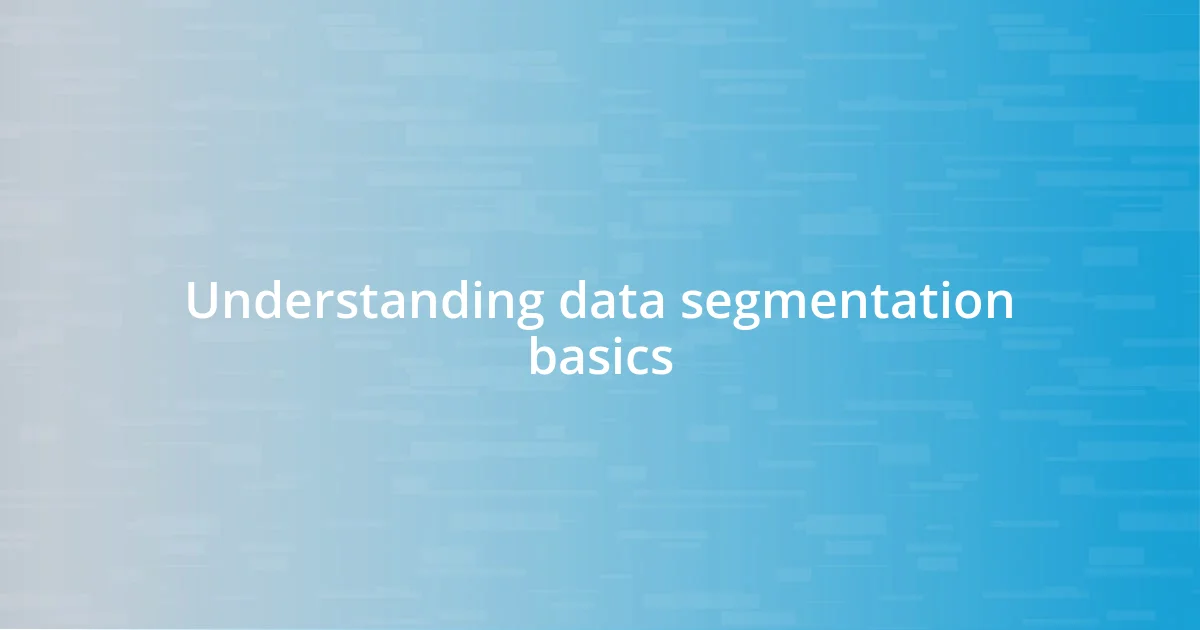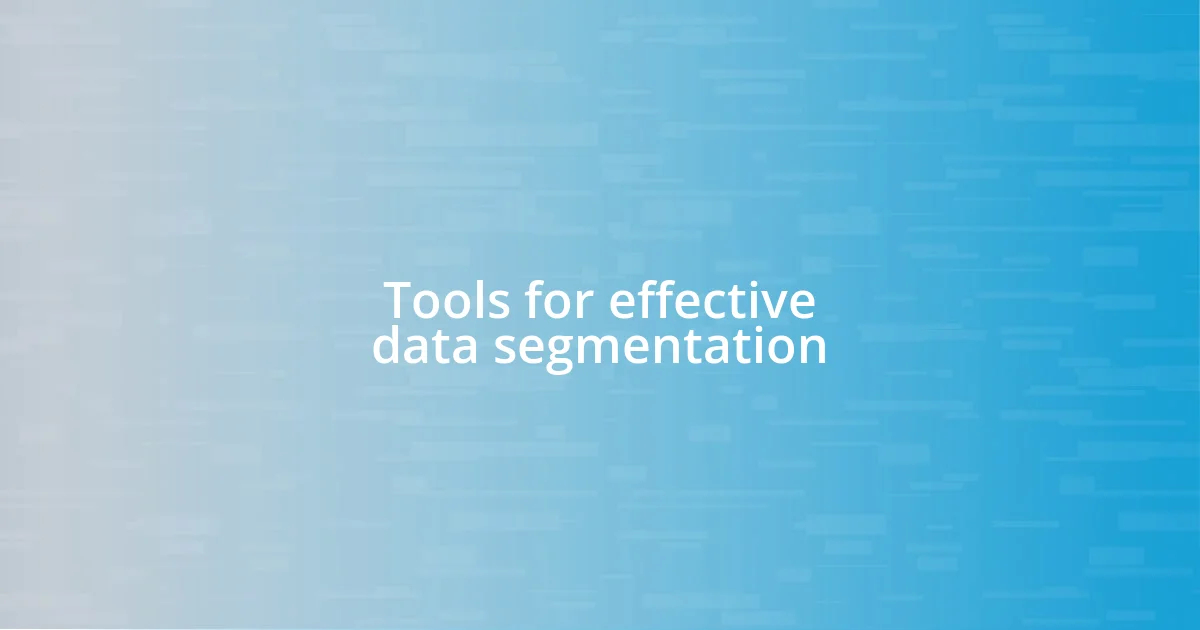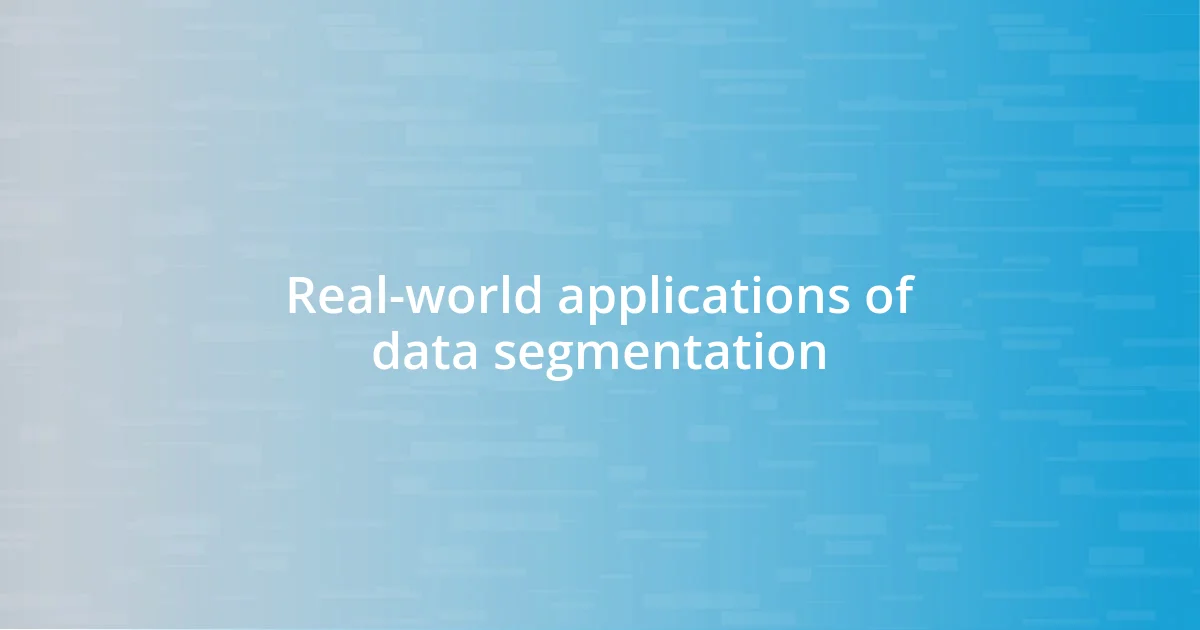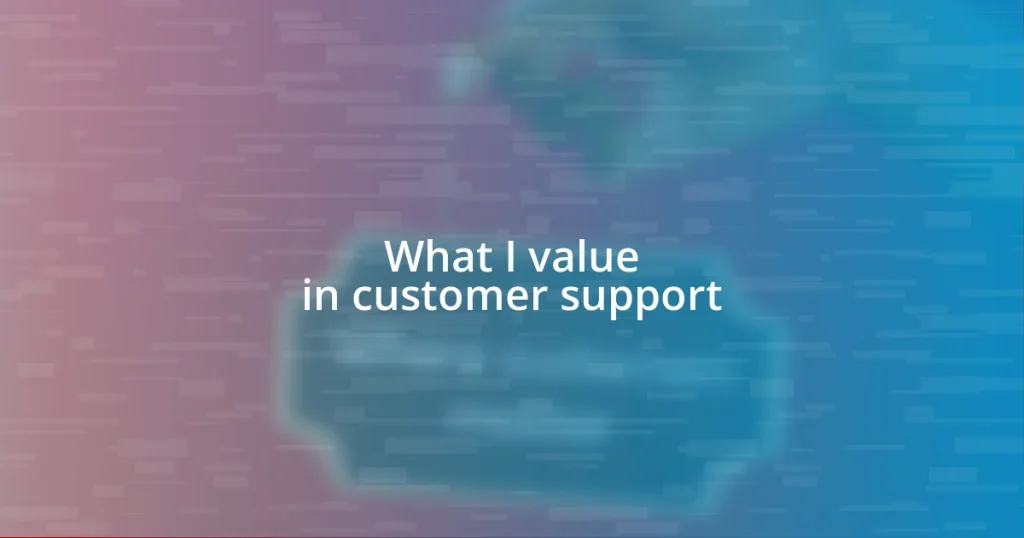Key takeaways:
- Data segmentation enhances personalized marketing, improving engagement rates and driving targeted campaigns based on customer behaviors and preferences.
- Common techniques include demographic, psychographic, and behavioral segmentation, each providing unique insights that help tailor marketing strategies effectively.
- Establishing clear objectives, continuously refining segments, and documenting the segmentation process are best practices that foster effective and accountable marketing efforts.

Understanding data segmentation basics
When I first delved into data segmentation, I was struck by its profound impact on understanding customer behaviors. It’s like putting on a pair of glasses that clarify the blurry details of who your audience really is. Have you ever felt overwhelmed trying to speak to everyone at once? Data segmentation allows you to slice that mass into manageable, targeted groups that resonate with specific needs and preferences.
As I navigated the world of data segmentation, I discovered just how essential it is to recognize that not all data is created equal. Segmentation often involves dividing a dataset based on characteristics like demographics, interests, or buying patterns. It’s almost like tuning a radio to find the perfect frequency—once you hit it, the message becomes crystal clear, and that’s when real connections can form.
One moment that really stands out for me was when I applied segmentation to a project. I had been sending out generic emails to a broad audience but saw minimal engagement. After segmenting the data into interest-based groups, I tailored my content. Suddenly, my open rates doubled! It made me realize that understanding the basics of data segmentation is not just a strategy—it’s a game changer.

Importance of data segmentation
Understanding the importance of data segmentation has been a real eye-opener for me. It’s not just about dividing data; it’s about unlocking potential. When I began to segment my audience, it felt like arranging a jigsaw puzzle where each piece represented a unique set of needs and behaviors. Suddenly, I wasn’t just sending out content into the void; I was having conversations with specific individuals who resonated with my message.
- Data segmentation enhances personalized marketing, leading to higher engagement rates.
- It allows for more efficient resource allocation, saving time and money.
- Segmented data drives targeted campaigns, increasing conversion rates.
- It provides deeper insights into customer preferences and behaviors.
- Segmentation helps to identify new market opportunities and trends.
One tangible experience that drives this home for me was during a product launch. Initially, the response was lukewarm. I took a step back, applied segmentation to identify loyal customers versus casual buyers, and crafted separate messages highlighting aspects they each valued. The result? A significant uptick in both sales and customer satisfaction—like finding the missing pieces of a complicated puzzle and watching it come to life!

Common data segmentation techniques
Data segmentation techniques can vary quite a bit, and knowing which ones to use is crucial. One method I often rely on is demographic segmentation. It takes into account age, gender, income, and other basic factors. I once used this approach for a campaign targeting young professionals. By tailoring our messaging to resonate with their unique lifestyle, we saw a noticeable increase in engagement.
Another technique I find invaluable is psychographic segmentation, which dives deeper into people’s interests, values, and lifestyles. For example, when I categorized a list based on values like sustainability versus luxury, it transformed how we approached our marketing strategy. The campaigns became much more aligned with the audience’s identity, and trust in our brand skyrocketed.
I can’t overlook behavioral segmentation, either. This technique focuses on how customers interact with your brand—things like purchasing habits or website activity. One memorable moment for me was when we analyzed customer behaviors after a holiday sale. We discovered that frequent shoppers responded better to loyalty rewards than new visitors did, leading us to customize our follow-up strategies accordingly. This approach not only boosted customer retention but made our marketing feel more personal and considerate.
| Segmentation Technique | Description |
|---|---|
| Demographic Segmentation | Divides the audience based on age, gender, income, etc. |
| Psychographic Segmentation | Focuses on values, interests, and lifestyles of individuals. |
| Behavioral Segmentation | Analyzes interactions with the brand, like purchasing habits. |

Tools for effective data segmentation
When it comes to tools for effective data segmentation, I’ve had great success with customer relationship management (CRM) systems. For instance, I remember the first time I integrated a CRM tool into my workflow; it felt like turning on a high-definition lens to view my customer base. Suddenly, I could easily filter my audience not just by demographics but also by purchase history and engagement levels. It was a transformative moment—I was no longer guessing what my customers wanted; I had clear, actionable insights in front of me.
Another powerful tool I’ve relied on is data visualization software. Have you ever tried to make sense of complex data without visuals? It’s like trying to read a novel in the dark. When I started using visualization tools, my ability to interpret and share insights dramatically improved. The charts and graphs painted vivid pictures of trends and clusters within my data that would have been nearly impossible to see in raw data tables. This clarity helped me take decisive actions, like fine-tuning my messaging based on where my audiences were most engaged.
Lastly, I can’t emphasize enough the value of A/B testing platforms in the segmentation process. I vividly recall a campaign where we were torn between two different approaches for email outreach. Leveraging A/B testing allowed me to send both versions to small segments of our audience. The results were enlightening! I learned not just which message resonated more, but also why it mattered to each segment. This tool empowered my decision-making and helped optimize my campaigns in real-time, making them far more effective overall. Isn’t it fascinating how the right tools can turn data into a story that captures the essence of your audience?

Analyzing segmented data trends
Analyzing segmented data trends offers a treasure trove of insights that can dramatically change the way we approach our marketing strategies. For instance, I remember a project where we segmented our data based on user location. By diving into the trends within different regions, it became clear that certain areas reacted positively to local events, while others preferred broader, national messages. This level of specificity not only refined our campaigns but also made each audience feel valued and understood.
One of the most eye-opening experiences I had was observing how seasonal trends influenced customer behavior within specific segments. I had a gut feeling that summer promotions would hit differently with families compared to singles. After analyzing the data, I was thrilled to discover that my instincts were right. Families jumped at offers tied to summer vacations, while singles preferred experiences over products. This trend analysis not only boosted our sales but also fostered a sense of connection with our various audience segments.
Engaging with segmented data also allowed me to uncover unexpected relationships. I once analyzed data from a retail campaign and was surprised to find that customers, who typically purchased eco-friendly products, also showed a strong preference for local brands. This correlation initially caught me off guard but opened up new collaborative opportunities. Isn’t it incredible how digging deeper into segmented data can not just answer questions, but also spark innovative ideas? The process of finding these trends feels like uncovering hidden gems, making every analysis session feel rewarding.

Best practices for data segmentation
Establishing clear objectives before diving into data segmentation is one of the best practices I’ve discovered. When I first started segmenting data, I often plunged right in, thinking the more segments, the better. However, I soon learned that having specific goals, like increasing engagement or improving retention rates, steers the segmentation process. Without clear objectives, it’s easy to get lost in the sea of data without making significant progress. Have you ever set out to achieve something without a roadmap? It’s a bit like sailing without a compass—you might end up anywhere!
Continuously refining your segments based on new insights is another critical practice. I recall a time when I thought I had nailed down a solid segment based on demographics alone. Yet, as I gathered more data and insights, it became evident that behaviors and preferences shifted over time. By revisiting and tweaking my segments regularly, I was able to adapt to these changes and better meet the needs of each group. This flexibility felt empowering; it’s almost like watching a plant grow and needing to adjust its support as it flourishes.
Finally, I can’t stress enough the importance of documenting your segmentation process. In the beginning, I would make changes but often struggle to remember why a particular segment was created or the rationale behind a specific strategy. Keeping a record of the decisions made, the data sources used, and the outcomes achieved acts as an invaluable reference. This practice doesn’t just help in streamlining future segmentation efforts; it also encourages accountability and continuous improvement. Wouldn’t you agree that having a history to refer back to is like a guiding light on your segmentation journey?

Real-world applications of data segmentation
When it comes to real-world applications of data segmentation, the impact on customer experience can be profound. For example, I once worked with a fitness brand that decided to segment their customer base into categories like beginners, enthusiasts, and competitors. This approach allowed us to tailor communications that resonated deeply with each group, delivering fitness tips, diet plans, and even product recommendations that aligned with their motivations. It sparked a surge in engagement; it felt like we were finally speaking their language!
In another instance, I was involved in a non-profit campaign targeting environmental conservation. By segmenting our supporters according to their preferred causes—like wildlife protection, recycling initiatives, or educational outreach—we were able to create personalized messaging that appealed to their passions. The joy on the team’s faces when donation levels rose was a testament to the effectiveness of this tailored approach. Isn’t it remarkable how aligning our outreach with people’s interests builds stronger connections and inspires action?
Moreover, I recall a digital retailer that leveraged segmentation based on purchase history. By identifying repeat buyers and first-time customers, they launched targeted campaigns that offered first-timers discount coupons while sharing exclusive new-arrival notifications with loyal customers. This strategy not only boosted their sales but also made customers feel appreciated, which is essential in a competitive market. Have you ever felt that rush of excitement when you discover a brand paying attention to your preferences? That’s the magic of data segmentation in action!














